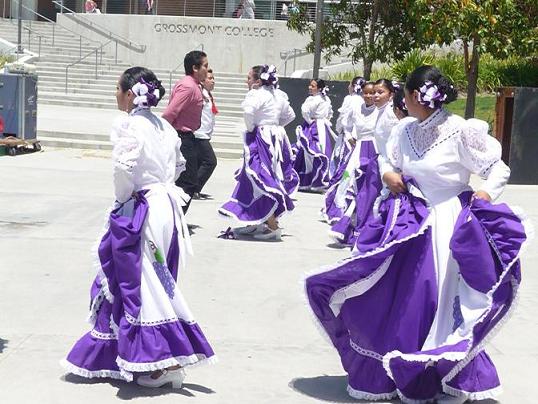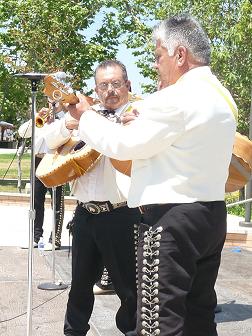
By Donald H. Harrison

EL CAJON, California–I’ve often wondered if one could “travel” the world while remaining in San Diego County.
In other words, can one sample the culture, the foods, and the ideas of all the different countries of the world, simply by taking advantage of the many international resources here at home?
The challenge would be to go to restaurants, attend lectures, watch movies, go to museums,enjoy international cultural events — all within San Diego County’s boundaries, and see if one could learn over several years at least something about every country on the globe. Isn’t this a tempting way to educate ourselves in our leisure time about the world?
My first opportunity to test the possibility of this exercise was the Grossmont College campus celebration here of Cinco de Mayo–the fifth of May–a day that Mexican forces in 1862 defeated an invading French army at the Battle of Puebla in 1862.
In Puebla, not surprisingly, the anniversary is a big deal, but people who have grown up in other Mexican cities say it’s not nearly as important as September 16th, which is Independence Day, Mexico’s national holiday.
Mimi Pollack, who teaches English as a second language, was born in the United States but grew up in Mexico as a result of her father’s job in that country. Noting that a celebration would be held on campus, she told her students that in Mexico City, where she lived, Cinco de Mayo was considered a minor holiday, “but Americans took it over and made it their holiday.”
Yolanda Guerrero, a Spanish professor and chair of the Grossmont’s foreign language department, suggested during the campus celebration that perhaps the reason why Cinco de Mayo was not such a big deal in Mexico was because although the Mexicans won that battle, they subsequently lost the war — The French Emperor Napoleon III was able to install Maximilian and his wife Carlotaas Mexico’s rulers.
It took several years before the Mexicans, with a little help from American volunteers, were able to oust Maximilian and restore the country’s independence.
So why has Cinco de Mayo celebrated become so widely celebrated in the United States? I asked Guerrero as folklorico dancers from the city of Atlacomulco in the state of Aguascaliente performed the “Pelea de Gallos” (Cockfight) dance in the background.
“To sell more beer, probably,” she said, with a smile.

Perhaps so, but not on campus. Alcoholic beverages are not permitted. The strongest refreshment available was a a pastry called “orejitas” (little ears), which were distributed to students for free, courtesy of Grossmont’s World Arts and Cultures Committee, which also underwrote the entertainment, logistics, and publicity, at a total cost of $1,300, according to Guerrero.
Guerrero provided me with a handout which pointed out that in 1862, the U.S. Civil War was in progress. The French were believed to be more sympathetic to the Confederate States of the South than to the Union States of the North, and might have intervened on the side of the South.
However, they were too tied up by the Mexican resistance to do so. “It might be a historical stretch to credit the survival of the United States to those brave 4,000 Meicans who faced an army twice as large in 1862. But who knows.” suggested the handout.
Eventually, according to that synopsis, Union forces were rushed to the Mexico-Texas border, where U.S. General Phil Sheridan, “made sure that the Mexicans got all the weapons and ammunition they needed to expel the French. American soldiers were discharged with their uniforms and rifles if they promised to join the Mexican Army to fight the French. The American Legion of Honor marched in the Victory Parade in Mexico City.”
Another possibility for the popularity of Cinco de Mayo in the U.S., Guerrero suggested, may be because it falls in the middle of the academic year for most public schools, whereas September 16th often is too close to the beginning of the school term to mount a proper celebration of Mexican culture.
Besides Mexican foods, which also were offered on another part of campus by the Phi Theata Kappa honors society, and the folkloric dancing, Grossmont’s celebration included performances by a mariachi group hailing from Athulense, a town near Guadalajara in Jalisco State.
The 12 Atlacomulco folkloric dancers, it turned out, were all students attending Grossmont College as part of a special 8-week program to train as middle school ESL teachers.
Among them were Paloma Diaz Miranda and Eli Cruz-Ceron, and their teacher, Raul de Jesus, who explained that different regions of Mexico have different folkloric costumes. The dresses that the young women wore were of a swirl-able purple and white design, and featured on its skirt an image of a bunch of grapes.
Besides the “Rooster Fight,” the troupe also performed “Polkauitas” a Mexican version of the polka, for the noon hour crowd on the Main Quad.
*
Harrison is editor of San Diego Jewish World. He may be contacted at donald.harrison@sdjewishworld.com
Pingback: SDSU archaeologists restored Maya royal residence in Belize | San Diego Jewish World
Pingback: Grossmont celebrates Cinco de Mayo « GCSummit